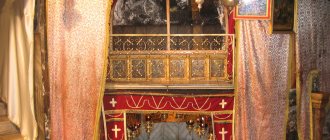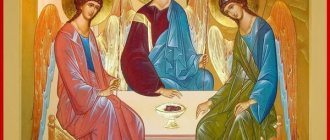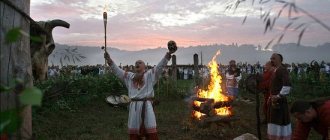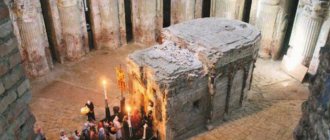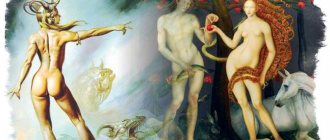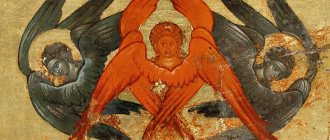In Europe, there has been a Christmas tradition for several centuries to install a nativity scene in or near the house. You can buy parts for this structure, or you can do everything yourself. In this unique setting, the Christmas performance of the birth of the baby Jesus is played out.
Since the action itself belongs to religious folk culture, in Russia this tradition was lost after the revolution. Its revival began in the late 80s along with the renewal of the Russian Orthodox Church.
In the new century, the nativity scene is again popular. It is staged by amateur and professional groups, on the big stage and at home - for friends and family.
What is a nativity scene
This word has several meanings, but many modern Russians are familiar with only one of them. Let's try to understand the intricacies and nuances of the concept from the very beginning
Origin of the word
The nativity scene is Old Slavonic in origin. Philologists have never come to a consensus on the etymology of this word. Its folk meanings: ravine, failure, gorge are closely related to the word cave, although “vrtep” was not a complete synonym for the word “peshtera” among the ancient Slavs.
Only one thing is indisputable - today it is believed that its roots come from the Old Slavonic “vrtep” - cave, the Serbo-Croatian “vrt” - garden, vegetable garden and the Latin “verti” - to close. Which literally means a closed, secluded place, refuge.
Meaning of the concept
In their famous dictionaries, Dal, Ozhegov, and Ushakov give several interpretations of the word.
Here is how Ushakov interprets it:
- Brothel, place of debauchery and crime (book).
- A box with puppets for presenting a drama based on the Gospel story about the birth of Christ (ethnogr., theater).
- This is the performance itself (theatre, ethnography).
The most interesting thing is that for the majority of our fellow citizens who grew up in Soviet times, the only meaning was number 1: a terrible place where dark personalities secretly gather to do their criminal deeds. Where did the second and third interpretations go?
It’s all very simple: the bright and festive meaning of the word “nativity scene” disappeared from people’s consciousness during the time of persecution of the church. Anti-religious propaganda led to the fact that Christmas, along with all its magic, ceased to be a national holiday, and its traditions were banned.
Today I would like to remember the very shelter where the Holy Family took refuge from the weather along with their livestock, where the Savior was born and what people came up with in memory of this great event.
History of the term
Like any ancient word, it goes back centuries. This means that modern researchers can only speculate, guess where the term came from and what its history is, relying primarily on written sources.
First use
In the Bible, “den” is used four times, each time as a den of thieves. We are interested in this word as the name of a place associated with the Nativity of Christ.
Let's try to arrange the milestones associated with the history of the word in chronological order:
- The Holy Nativity Scene, or Cave of the Nativity, was first mentioned in the apocryphal Proto-Gospel of James around the year 150. The author writes about a cave near Bethlehem as the birthplace of the Savior. Today this cave is located under the pulpit of the Church of the Nativity of Christ. There on the floor there is a silver star and an inscription in Latin: “Here Jesus Christ was born of the Virgin Mary.”
- There is no exact date associated with the first creation of a place illustrating the gospel story. According to researcher Boris Goldovsky, performances of the Christmas mystery appeared in the 5th century. It was then that voluminous panoramas of the Bethlehem Cave with a baby in a manger, surrounded by livestock, the Virgin Mary, shepherds and wise men began to be created in churches.
- Scientists attribute the creation of the first secular installation on the theme of the appearance of the Savior to the world to the Catholic Saint Francis of Azsisi, who celebrated Christmas in the village of Greccio in 1223. As the climax of the holiday, he composed a living composition of the Christmas story or, as the Italians call it, “presepe” (manger). It was since then that the tradition arose of installing presepe not only in churches, but also in the homes of believers.
- The first reliable information about theatrical puppet shows with a Christmas plot in Rus' dates back to the end of the 16th century. The earliest found crate is dated 1591.
Further fate
The heyday of nativity scenes occurred in the 18th-19th centuries. In Russia, the popularity of this performance was so great that by the end of the 18th century, a family affair had developed in St. Petersburg: the Kolosov dynasty of nativity scene makers carefully preserved and passed on the traditions of performing performances from fathers to children throughout the next century.
The performance consisted of two parts. The first is the gospel mystery about the birth of the Savior. In the second, satirical farce scenes were played on everyday subjects.
Gradually, the secular folk performance became so popular that nativity scene makers began to tour with their magic boxes not only at Christmas time, but also later - right up to Maslenitsa.
After the October Revolution in 1917, faith in God and everything related to religion was persecuted: the Christmas tree, Christmastide, festivities and nativity scenes, among others, were prohibited. The Christmas tree as an attribute of the New Year celebration soon returned to people's homes, but the nativity scene was gradually forgotten.
Modern meaning
At the end of the 80s of the last century, when the state finally reconciled with the church, Russian folklorists began searching for lost religious folk customs, including nativity scenes.
Puppet theater researcher and director Viktor Novatsky did a lot for this. He collected bit by bit the elements of the nativity scene tradition, restored the script and texts of the action, and breathed life into the characters of the Christmas story.
Today, these performances again delight the Christians of our country on the days of the main church holiday - the Nativity of Christ.
The meaning of the word nativity scene
(German Christschau, Polish Szopka, from German Schoppen - stable or barn) - this is what they are called in Little Russia, Poland, Belarus and some. places in Siberia, performances aimed at depicting the Nativity of Christ and events associated with it. V., apparently, penetrated into our old theater from Poland, no earlier than the end of the 16th century. In the West, there have long been spiritual and theatrical rituals performed at Christmas (see Mysteries). From here it was easy for them to penetrate into Catholic Poland, and then into Little Russia. Polish szopka, which at that time (16th century) became a common recreational activity of Polish seminarians who walked around cities and villages with their miniature theater, in our south received the name “nativity scene”. This kind of spiritual and theatrical performances was very popular in Ukraine and only in the last two decades began to disappear. The seriousness of the content of the nativity scene did not prevent folk humor from penetrating into it. In the person of Herod, warriors beating infants, shepherds who came to worship Christ, and others, types of a purely local character were often embodied.
A Polish or Little Russian nativity scene is a small wooden box or house with two tiers: the upper one represents the serious part of the “action” (spiritual), and the lower one represents the interlude. By the hand of a lively walker (called the nativity scene maker), hidden behind, invisibly for the audience, dolls and figures are set in motion, for which the nativity scene maker himself speaks, changing his voice according to the role. Together with V. they usually wear a “ star ”. The prologue to the nativity scene is the singing of carols and “kantychkas” performed by the bearers of the nativity scene and the star. V. is often accompanied by a home-grown orchestra, in most cases consisting of a violin and tambourine. Ukrainian V. was studied by N. Markevich in the book “Customs, beliefs, etc. of the Little Russians” (Kyiv, 1860), where the full text of one of the nativity plays is given. After the opening choir, the sexton appears, inviting everyone to announce the birth of the Savior. The action is accompanied by a number of sacred cants, interrupted by individual phenomena, which depict: the worship of the shepherds, Herod and the three kings, the beating of the infants, the cry of Rachel and the death of Herod, whom the devil drags to hell. There is nothing to be afraid of the dead Herod, and therefore the did and the woman - a comic intermezzo - dance to the sounds of the song “Oh, under the cherry tree, under the cherry tree.” Behind the grandfather and grandmother comes a soldier, giving a speech to the audience in which he deliberately distorts the Great Russian dialect. The soldier certifies himself: “I am a simple soldier, not a theologian, I don’t know sinful words. Although I am the essence of defense for the fatherland, my back is beaten. I don’t know how to read or write, but I say what I understand,” etc. The soldier is replaced by a gypsy with his wife and son. The gypsy takes out her anger on the gypsies for their poverty; a quarrel turns into a fight; the matter ends with peace and dancing to a lively song, in which the wandering gypsy life is ridiculed. Then a Hungarian and a Pole appear on stage, each with their own characteristics. The Pole, a formidable landowner, is portrayed as a braggart, especially proud of his ancestors. Together with his wife, the Pole usually dances the Krakowiak. The scene ends with scolding at the boy for sneaking up and imitating his master; the angry landowner says: “Pudz dzembla, laidak!” I’ll kill you with batogs.” The swearing of the master falls silent when the Cossack, the main character of the play, appears. Backstage, he sings his favorite Little Russian song: “It won’t be better, it won’t be more beautiful, like here, like in Ukraine!” The well-dressed Cossack is deliberately depicted as an endangered type, sadly recalling the dashing old days: “Ay, gentleman, what was it when I was young, that’s why I had strength!” The thoughts are followed by tomfoolery over the gypsy sorceress and over the Jew, whom the Cossack hands over to the devil. The Cossack treats the devil as an equal, and this again shows his courage: he even urges the devil with his mace to quickly remove the Jew. The oppression of the union is not forgotten here either. The Cossack boldly responds to the admonitions of the Uniate priest to go to church and bow more: “I never went to church and never bowed, but I will beat you!” Finally, in the person of the sexton, who speaks a semi-ecclesiastical language incomprehensible to the common people, seminary learning is ridiculed. The peasant Klim gives the clerk, in exchange for money for his son’s apprenticeship, a pig, old and lascivious, which no one buys; the clerk, confident that he has deceived the man, accepts her with pompous gratitude.
A comparison of the text of the spiritual scenes of the Little Russian nativity scene with the corresponding Polish and German texts makes it probable that the Little Russian nativity scene was composed by students of the Kyiv Academy in later times and not earlier than the beginning of the 18th century. The Polish influence affected only the general structure of the play, but the details were worked out independently.
The reflection of real life in nativity plays is the main reason for the speed with which nativity scenes spread across the whole of Russia. In Belarus, the nativity scene appeared in the 1830s; here it is often called betleika (from Betleem - Bethlehem). Mr. Kulzhinsky, who saw and described the Belarusian betleika (“Betleikas in the North-Western Territory,” in “Soulful Reading,” 1873, vol. III) says that the betleika “is completely uncensored and has almost nothing to do with the Nativity of Christ; “It is especially strange to mix sacred images with clownish ones, and yet the betleika is popular here and loved by the common people.”
Settlers or exiles probably brought the nativity scene to Siberia, where the puppets are called lords and heroes. Eyewitnesses of Siberian nativity scenes describe their structure as similar to the Little Russian nativity scene. N. Polevoy in the “Repertoire” for 1840 (in the article “History of the Russian Theater. My Memoirs”) describes the nativity scene he saw in Irkutsk in the first years of this century. The play of horn players and violinists accompanies the performance (cf. Snegirev, “Russian Common Holidays”).
In northeastern Russia, a special kind of nativity scene was created under the new name raika , which probably originated from the ideas in nativity plays about heaven and torment . It must be assumed that the puppet theater was also brought to Moscow from the south; but here the character of the district is influenced by those introduced from the end of the 17th century. from the West of amusements, on the one hand, and the development of popular prints, on the other, it changes, and from a puppet theater, Paradise turns into a folk panorama: glass is inserted into the nativity scene, puppets are replaced by paintings, and the nativity scene’s owner’s sayings are replaced by the speech of the nativity scene. In addition to the above works, cf. Konopka, “Piesni lu du krakowskiego” (1840, 85-90); Jos. Sikorski, “Jasełka” (in the magazine “Pamiętnik muzyczny i teatralny”, 1862, nos. 2 -15); Kolberg, "Lud" (V, 197-226); “Ethnographic collection” (I, 320 - 322); Shchukin, “Nativity scene” (“Bulletin of the Imperial Russian Geographical Society,” 1860, VIII, 25 -35); Galagan, “Little Russian Den” (with a preface by Zhitetsky, in “Kyiv Antiquity” 1882, book 10, with drawing and notes); O.P., “An outgoing or initial form of nativity play drama?” (ibid., 1883, No. 4); "On the issue of nativity comedy in Ukraine." (ibid., no. 12); Bessonov, “Belarusian songs” (98-99, 104-105); Alexey Veselovsky, “Ancient Theater in Europe” (Moscow, 1870); P. Morozov, “Essays on the history of Russian drama of the 17th - 18th centuries” (St. Petersburg, 1888).
Work and arrangement of the nativity scene
After the end of the Nativity Fast, the winter holidays begin. These days are full of prognostic signs, rituals, and customs. One of them was a nativity scene.
If you follow established traditions, there are several forms of Christmas performance:
- nativity scene composition - three-dimensional figures of the mystery characters of various sizes, exhibited in the appropriate decoration;
- nativity scene puppet theater is a performance in a specially equipped space (box) with the participation of musicians and singer-storytellers;
- a theater with human actors performing the roles of all or some of the characters.
The static composition “presepe” is still very popular in Europe. But the Russian people have always preferred the puppet show, the Christmas mystery, representing scenes from the Holy Scriptures.
In Rus'
A large box-house with two tiers, inside which the performance was performed, was carried from house to house, and performances were staged at inns and fairs. The nativity scene was installed on a raised platform, spectators took a place on the arranged benches, the sexton lit the candles and the magic began.
The most important thing is that it was not just a wonderful box, it was a model of the universe.
The upper tier, the heavenly world, was the abode of the Holy Family. The lower one - the lower one - showed the palace of King Herod and the events surrounding the birth of Jesus. There was also an entrance to hell, into which the king, defeated by Death, fell.
Under the floor of each tier there was another compartment, closed from the viewer. There were the hands of the nativity scene maker; he held the dolls by special pins and moved them along the slots in the floor. The characters were usually voiced by the puppeteer himself, changing his voice and manner of speaking.
Musicians often took part in the action and performed spiritual chants. The music gave the characters very precise characteristics and filled the performance with celebration.
The traditional cast of characters remained unchanged:
- The Holy Family: the Virgin Mary, Joseph, the baby Jesus lying in a manger, nearby an ox and a donkey, which, according to legend, warmed the newborn with their breath - most often they were a static group and had no words. Instead of figures, sometimes they put an icon of the Nativity.
- The Star of Bethlehem is one of the main characters. It was necessary for her to be noticeable and beautiful. Usually, the star was made through and illuminated from behind with a candle so that it flickered mysteriously.
- The angel who announced the birth of God. In the Orthodox tradition, this was the Archangel Gabriel.
- Shepherds with a flock of sheep. One of them holds a lamb on his shoulders or in his hands as a symbol of the Lamb of God.
- The Magi are a triune character mounted on one pedestal. They come to worship Christ and bring him gifts: gold, incense and myrrh.
- King Herod. In the brightly decorated “palace” in the lower tier, his atrocities in the city of Bethlehem and the punishment that followed were played out.
- Rachel is a woman with a baby who comes to the king with a vain plea not to kill her son.
- Death in black clothes, with a skull instead of a head and with a scythe, with which he cuts off Herod's head.
- Demon. By order of Death, he dragged the villain to hell.
According to religious canons, it was impossible to create an emotional, spectacular, Christmas performance. Acting was not allowed in it. The nativity scenes served only as illustrations of the texts of the Holy Scriptures.
After Christmastide, the spiritual part of the performance was forbidden to be shown, only the secular part remained. Nevertheless, the nativity theater was a favorite entertainment for children and adults, regardless of their income and class.
In modern world
Today, like hundreds of years ago, nativity compositions are arranged in churches before Christmas. European primary schoolchildren perform a Christmas mystery for their parents and friends on the social stage. In Russia, such productions (also by children) are organized by church Sunday schools.
Nativity scene compositions can be very original, for example, with real pets. The first one was organized in 2013 at the Cathedral in Pyatigorsk.
Another national Russian tradition is a cave made of snow. Illuminated from the inside, it looks very mysterious.
Real puppet shows in nativity scenes, according to ancient traditions and canons, are performed by numerous folklore groups.
We can say that in modern Russia, Christmas nativity scenes have become an indispensable attribute of the holiday.
Significance in history
The nativity scene has confirmed its right to life, having traveled more than a thousand years from the times when it served as a kind of Bible for ordinary illiterate people to the present day.
Panoramas illustrating the biblical events of Christmas night truly strengthened faith and placed the birth of Christ among events of exceptional significance for all believers.
And even though the same plot is repeated every year and everyone knows it by heart, the Christmas miracle embodied in nativity scenes gives birth to love and faith.
Christmas nativity scene: from the history of the emergence of the symbol of a wonderful holiday
Christmas is an amazing time when the heart is filled with the expectation of a miracle... And this miracle happens!..
There is a wonderful old tradition - to put up a nativity scene in the house at Christmas.
Nativity scene is an old Russian word. It means a cave. According to the Holy Scriptures, the Son of God - the Infant Jesus Christ - was born in a den where the Virgin Mary and the righteous Joseph stopped for the night.
In the Russian Orthodox tradition, Nativity scenes have never been revered as much as in the West, where they came from. First to Ukraine and Belarus, then to Russia. In Russia, theatrical performances were first blessed only in the 17th century with the arrival of Tsar Alexei Mikhailovich, who loved theatrical performances and gladly invited actors. The eighteenth century became the heyday for the Russian nativity scene.
The Nativity scene is a model of the Bethlehem cave with dolls inside, or you can call it a Christmas puppet theater. It can also be compared to the Christmas home liturgy for children: the remembrance of the birth of Christ, carried out through dolls, through a small theater.
Time passed, and from the hands of the masters began to emerge wooden carved nativity scenes, made of cardboard and papier-mâché, clay, porcelain, plaster... Refined and simple, large and small panoramas, reproducing the scene of the Birth of the Savior, were a kind of Bible for the illiterate.
It is from this Christmas nativity scene that the history of puppet theater in Rus' begins. Christoslavs walked from house to house, glorifying the birth of the Savior, and among them were those who again and again told the eternal story of the birth of the Son of God.
The nativity scene moved from village to village, protecting the earth from everything evil that happens in the world and symbolizing the ark of salvation. In winter, he was carried on a sleigh, carried from hut to hut, and shown performances at inns. Benches were placed around the nativity scene, candles were lit, and the fairy tale began.
What was the Christmas nativity scene like? The nativity scene was a simple wooden or cardboard box with slits, open at the viewer's side, it could be up to 2 meters high and one meter wide. The nativity box itself was a house with two floors, which according to Christian tradition were interpreted as “heaven” and “earth”, and at the bottom there was a hole - “hell”, where Herod falls. The vertepnik was located behind and moved the doll along the slots in the floor, watching the action through special windows.
The entire upper tier of the house was decorated according to the Christmas scene. It was covered with blue paper or painted blue. The Christmas Star of Bethlehem was carved onto the roof of the house, announcing to the whole world the miraculous birth of the Son of God. This Star was through. From the inside of the house it was illuminated with a candle. And she really did shine with a twinkling light during the Christmas pageant.
The inside of the box was covered with white hare skin. White color symbolized purity. At the same time, the hare skin hid the slots in the box through which the figures moved.
In the evening, several multi-colored lanterns were hung on the sides and top of the box for illumination.
The stage was covered with a bright fabric curtain or shutter, hiding the changes between scenes from the audience.
Each character had his own playing space and moved strictly within its boundaries. The upper tier of this house, in fact, represented the cave of the Nativity. It housed a small manger in which lay the swaddled Infant Christ; figurines of Joseph and the Virgin Mary bending over the manger; an ox and a donkey warming the Savior with their breath.
These figures could not be called just dolls: they were never played with as dolls, no speeches were made for them. They depicted a Christmas scene and were signs, symbols of Christmas. Sometimes, instead of figurines, an icon of the Christmas holiday was placed in the upper tier.
Dolls were made of wood, sometimes clay. They painted faces, dressed heroes in clothes made of fabric and paper; a wooden or wire rod was attached to the leg. The vertebratist himself “played” for everyone, changing his voice depending on the character’s character. There could also be musicians and a choir behind the box.
The classic “troupe” of the nativity scene is the Mother of God, Joseph, the Angel, the Shepherd, the three Magi Kings, Herod, Rachel, the Soldier, the Devil, Death and the Sexton, whose duty was to light the candles in the nativity scene before the performance. Each doll was attached to a pin, which the puppeteer could grasp from below, like a handle, and move it along special slots in the stage floor.
A baby in a nativity scene, as a rule, is a tightly twisted flagellum of white matter; The sheep with which the shepherd comes to worship Christ are a curly ball of yarn. As a rule, the characters in the nativity scene are made of wood or rags, from simple, cheap material - they are easy to make and easy to carry.
However, there was an unwritten rule among nativity scene makers: a doll depicting the Virgin Mary should be made differently than all the others, as if it had been made by another artist. Therefore, the images of the Mother of God and the Savior were created by master nativity scene makers with special care. Sometimes an icon was placed instead of a doll of the Mother of God.
There were some simple tricks of the nativity scene. For example, how do the Magi kneel before the Child? (As it turned out, the chick from which the sorcerer was made was shorter than the drapery he was wearing). How does Herod's head fly off his shoulders when Death cuts it off with his scythe? (Herod’s doll was not made from a single piece of wood, but was attached to a pin by which the character was led. Pull the pin down a little and your head would be off your shoulders!)
How did the action take place?
The top tier of the nativity box was called the “sky,” “cave,” or “stable”; the inside was covered with blue paper with foil stars; on the back wall a Nativity scene was depicted, or next to it there was a semblance of a cave or stable with a manger, as well as motionless figures of Mary, Joseph, the baby Jesus Christ, and domestic animals.
The lower tier was called the "ground" or "palace"; episodes of the atrocities and punishment of King Herod, as well as everyday scenes of a comic and satirical nature, were played out here. The “palace” was decorated with bright colored paper and sparkles; in the center was the throne on which Herod sat. Three warriors armed with pikes and swords were sometimes fixed motionless on both sides of the throne. The rest of the dolls “entered” and “exited” through two doors in the side walls of the box.
In the second part of the performance, everyday scenes are shown, then the characters “say goodbye” to the audience.
According to contemporaries, the nativity scene was a favorite Christmas pastime and was liked by a variety of spectators, regardless of age, origin and social status.
Over time, the nativity scene turned into a puppet theater familiar to us, because over the years the dolls acquired various mechanisms that allowed them to move their limbs.
Although decorating churches with Christmas scenes is now tightly associated in our minds with the Catholic tradition, in the 18th–19th centuries in Ukraine, Belarus, the Pskov region and Siberia, on Christmas days one could meet children and adults walking around with a nativity scene and giving simple performances. These were the forerunners of puppet theaters - their more edifying, but no less colorful and popular version.
A common picture for a rural pre-Christmas landscape: children in high homemade crowns with sticks in their hands represent the “Persian kings” who came to bow to a small child. Traveling with them is a small wooden box decorated with gilded paper and unsightly drawings, a hand-made nativity scene or a festive theater for dolls with a roof made of two boards. Usually, children in costumes carried their Christmas box on a sled, and when they climbed onto the porch, they asked the owners of the houses for permission to carol. If they agreed to accept the carols, the kids brought their theater into the house, placed it on two chairs or a table, and the fairy tale began.
By the end of the century, the farce scenes played on the lower floor turned out to be more significant than the events of the “upper tier.” The nativity scene makers began to carry the wonderful box to fairs, not only on Christmastide, but they went with it right up to Maslenitsa. It is known that some artists even went with nativity scenes to the Nizhny Novgorod Fair. By the way, the “instructor for all Russian trade” opened on July 15!
The October Revolution of 1917 and the anti-religious campaign that followed it decided the fate of Christmas performances. They, like the traditional Christmas tree, were strictly prohibited. Soon the texts of nativity plays were lost and the secrets of driving dolls were forgotten. Only in 1980 did the revival of the traditional nativity scene begin.
The main spectators and visitors of Christmas nativity scenes are children. And there is no need to explain for a long time why: looking at the mysterious nativity scenes, they seem to be transported in mind and heart to Bethlehem, to the manger of the Infant Christ.
Nativity scene in the Pskov-Pechersky Monastery
Nativity scene in the Kiev Pechersk Lavra
Snow nativity scene at the Holy Trinity Church in Tomsk
Snow nativity scene in Akademgorodok, Tomsk
Snow chapel near the Church of the Smolensk Icon of the Mother of God, Dubna
Nativity scene made of ice. Catherine's Cathedral in Tsarskoe Selo
Nativity scene with real animals in Pyatigorsk.
St. Sophia Cathedral, Tsarskoe Selo
Some people buy a nativity scene in a store or at a fair, others prefer to make it themselves. In Europe, this tradition has never been interrupted; it has been around for many centuries.
How to experience the miracle of Christmas - especially if there are small children in the house? One possible solution is to make a nativity scene. Working together with children and other household members will in any case bring joy.
You can make a nativity scene with the whole family, and then read good Christmas stories, sometimes, if possible, enlivening the action.
But when making a nativity scene, you need to know some rules for its construction. The symbolism remains the same: heaven above, hell below. The figures of the holy family are placed on the top tier if the nativity scene is two-tiered and on the left if it is single-tiered. And only earthly creatures are voiced.
The nativity scene has been and remains one of the favorite traditions of celebrating Christmas. And whatever it may be, static, mechanical or even alive, with the participation of human actors, for the viewer it is, first of all, a wonderful sign pointing to that very Bethlehem cave.
Rozhdestvenskoe
In the manger, the quiet tiny Christ slept on fresh hay. The moon, emerging from the shadows, stroked the flax of his hair... The bull breathed on the baby's face And, rustling like straw, he looked at the elastic knee, barely breathing. Sparrows through the roof poles poured into the manger in a crowd, And the bull, pressed against the niche, crumpled the blanket with his lip. The dog, sneaking up to the warm leg, licked it secretly. The cat was the most comfortable of all, In the manger, warming the child sideways... The subdued white goat was breathing on his forehead, Only the stupid gray donkey Helplessly pushed everyone: “If only I could look at the child for a minute!” And he cried loudly and loudly in the pre-dawn silence... And Christ, opening his eyes, suddenly parted the circle of animals And with a smile full of affection, Whispered: “Look quickly!..” S. Cherny
